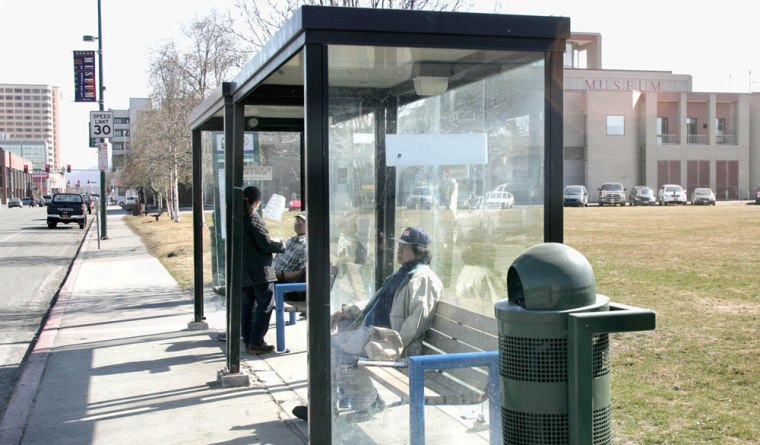Tom Wilson is faced with a problem many city administrators would envy: How to spend $1.5 million on a bus stop.
Wilson, Anchorage’s director of public transportation, has all that money for a new and improved bus stop outside the Anchorage Museum of History and Art thanks to Republican Sen. Ted Stevens — fondly referred to by Alaskans as “Uncle Ted” for his prodigious ability to secure federal dollars for his home state.
Wilson is prepared to think big.
The bus stop there now is a simple steel-and-glass, three-sided enclosure. Wilson wants better lighting and seating. He also likes the idea of heated sidewalks that would remain free of snow and ice. And he thinks electronic signs would be nice.
“It is going to be a showpiece stop,” Wilson said.
He acknowledges the money has put him in an awkward position.
“We have a senator that gave us that money, and I certainly won’t want to appear ungrateful,” he said. At the same time, he does not want the public to think the city is wasting the money. So “if it only takes us $500,000 to do it, that’s what we will spend.”
That is still five to 50 times the typical cost of bus stop improvements in Anchorage.
Part of $388 billion spending bill
The money was contained in a $388 billion spending bill passed by Congress in November, when Stevens was head of the Senate Appropriations Committee.
Citizens Against Government Waste has ranked Stevens No. 1 every year since it began calculating lawmakers’ proficiency at bringing home pork in 2000. In 2005, Stevens brought home more than $645 million, or $984.85 for each Alaskan, the group says.
City and museum officials agree that the bus stop must fit in aesthetically with a museum expansion project that is being funded with $75 million in public and private money. In fact, the museum has offered to help design the bus stop.
The museum’s architects want the bus stop to be compatible with the exterior building materials used for the expansion — glass with a pattern that gives the impression of looking through a thin curtain.
Mustn’t spoil the view
And they do not want it to spoil the view of the street that museum visitors will have when they stand in what will be a mini-forest of 350 birch trees whose lower branches have been cut away.
If done right, the expanded museum and improved bus stop could anchor a new eastern edge to the downtown area, drawing not only more tourists to the museum but shoppers from a nearby mall and workers from the federal building, said museum director Pat Wolf.
That is what Stevens had in mind when he got the $1.5 million, said the senator’s spokeswoman Courtney Boone.
“It is supposed to be a lot more than a bus stop,” she said. “It needs to have a way to smoothly transition all these people.”
Call it ‘infrastructure development’
And Boone said there are good reasons Stevens strives to bring federal dollars to Alaska. For one thing, it is more difficult and costly to build infrastructure in Alaska, she said.
“Sen. Stevens does not believe the money that he is able to work diligently to secure at the federal level is pork,” she said. “He considers it infrastructure development for a very young state. People seem to forget how young Alaska really is.”
Waiting for a bus, Ronnie San Ramon imagined what he would do with $1.5 million. With winter still a fresh memory, he suggested making the bus stop fully enclosed and heated.
“People in winter are frozen — especially if the bus is late like today,” San Ramon said.
